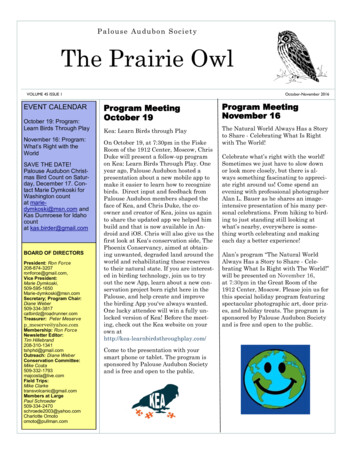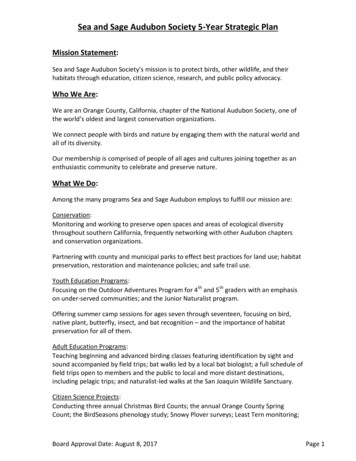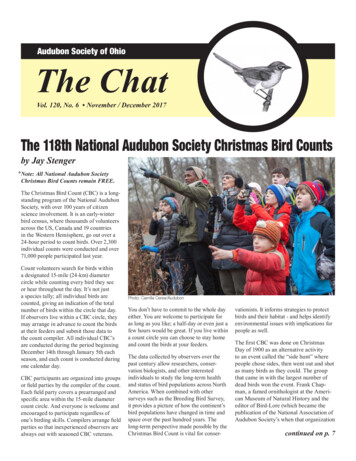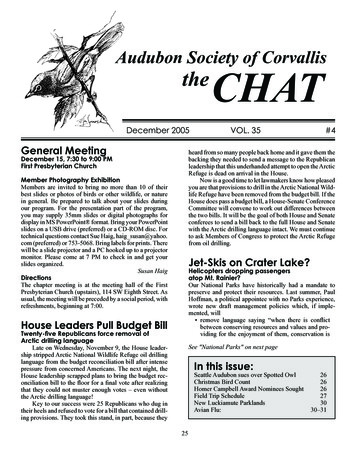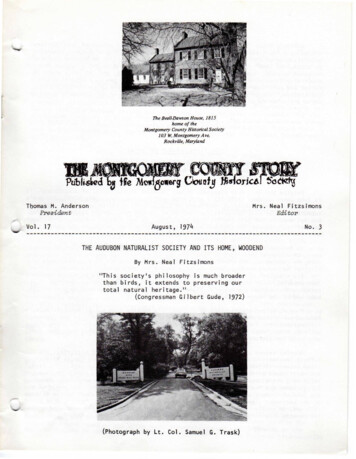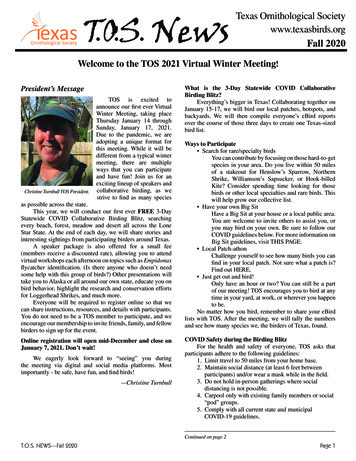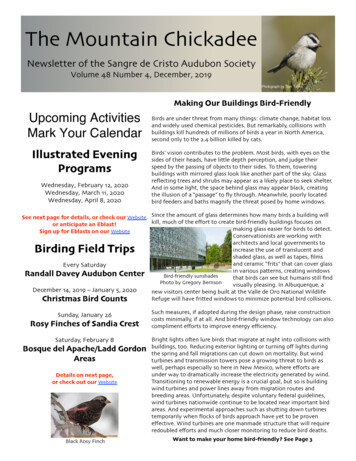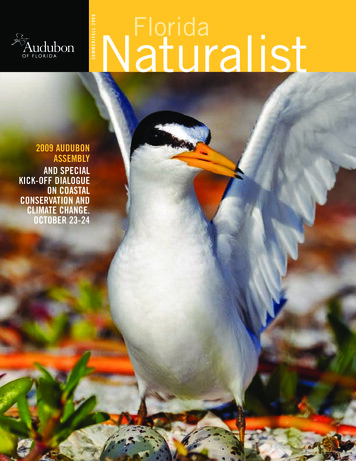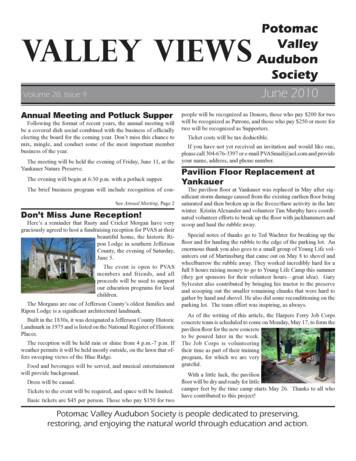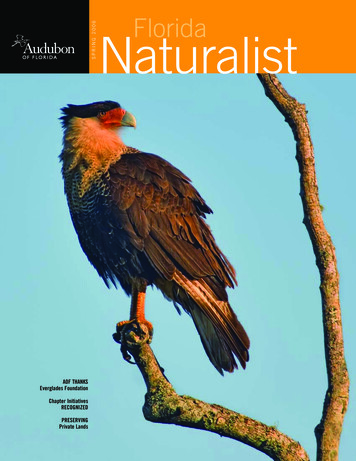
Transcription
SPRING 2006AOF THANKSEverglades FoundationChapter InitiativesRECOGNIZEDPRESERVINGPrivate LandsFloridaNaturalist
2006Board of DirectorsJohn F. Flanigan, Esq., ChairmanMoyle, Flanigan, Katz, Raymond & SheehanDoug Pitts, Sr., Vice ChairCourtelis CompanyJoyce King, SecretarySt. Petersburg Audubon SocietyJ.T. Ambrozy, TreasurerPhilanthropistCarole A. AdamsDuval County AudubonSandy BatchelorBatchelor EnterprisesWilliam O. Birchfield, Esq.Birchfield & Humphrey PAJulie ByrneSarasota Audubon SocietyErnie CaldwellWaterfront Management Services, Inc.Peggy CoxOrange County Audubon SocietyHenry DeanFormer Executive DirectorSouth Florida Water Management DistrictVictoria F. GarrigoNorthern Trust BankCarl C. Gill, MDDirector, Cardiac Surgery,North Broward Hospital DistrictRichard Gragg, Ph DFlorida A&M UniversityEnvironmental Sciences InstituteCynthia GuerraTropical Audubon SocietyJohn Hankinson, Jr.Creative Solutions for the EnvironmentCarlos Lacasa, Esq.Ruden, McClosky et alNeil J. Lamb, Ph.D.Bay County Audubon SocietyJohn Robert MiddlemasPeoples First InsuranceHelen ObenchainLake Wales Ridge Regional CouncilChelle PlasséDisney’s Animal KingdomDouglas SantoniRoyal Caribbean Cruises Ltd.John SoreyManagement Support Systems, Inc.Barbara Sheen ToddPinellas County CommissionerNeta Villalobos-BellSeminole Audubon SocietyDouglas Warns, Ph.D.Martin County Audubon SocietyEXECTIVE DIRECTOR’S MESSAGESolving today's environmental challenges is complex. We must find a balancebetween the pressures of explosive growth and the need for environmental sustainability.We must restore unique ecosystems and habitats that birds and wildlife depend upon.And we must acquire natural areas to ensure their protection in perpetuity.Audubon of Florida could not address thesechallenges without support from and the work ofour strategic partners. In February, I was pleasedto present Senator Bob Smith, President of theEverglades Foundation, with the fruit of animportant labor, the Lake Okeechobee Report.The Report, like many of our accomplishmentsin restoring the Everglades, is possible becauseof funding from the Everglades Foundation.Support also came from a variety of foundations,in particular, the Batchelor Foundation, whichhas been most generous in recent years.The Lake Okeechobee Report is an in-depth,scientific assessment of this crucial ecosystem,researched and written by Dr. Paul Gray, Chris"Restoration and protection of Everglades ecosystemsFarrell, Dr. Mark Kraus and April Gromnicki.would not be possible without the strong supportof Audubon of Florida. You really have done a lotIt examines the Lake's natural resources, waterof good work on the Lake," said Senator BobSmith, president of the Everglades Foundationlevel management, water quality and exotic(right), pictured with David Anderson.species, and it makes specific recommendationsfor its restoration. We deeply appreciate the Everglades Foundation's support of thismajor contribution to the health of this critically threatened Lake.Audubon of Florida, since the early 1990s, has enjoyed a long and productiverelationship with the founders of the Everglades Foundation. Back then, Paul Tudor Jonesand George and Mary Barley were instrumental in helping us establish the first AudubonEverglades Office in Miami. Other key supporters were Bill Riley and Nathaniel Reed.The steadfast support, advice and encouragement from these individuals, andthe support of the Everglades Foundation, have enabled Audubon of Florida and itsenvironmental partners to develop strong science and advocacy to restore LakeOkeechobee and the Everglades. Significantly, sound science and powerful advocacywere keys to ensuring the conception, development and passage of the ComprehensiveEverglades Restoration Plan (CERP) and other initiatives within the Everglades ecosystem.Science and advocacy will continue to be a recipe for successful implementation ofthese plans.We thank the Everglades Foundation and the individuals who are a part of it fortheir consistent commitment to conservation and for supporting Audubon of Floridaand its strategic partners. Challenges still exist, but working together, we will continueto be effective in restoring ecosystems and protecting birds and wildlife.David E. AndersonExecutive Director, Audubon of Florida
Birdhouses painted and donated to the fundraising auction included these by (left to right) writer Carl Hiaasen, artistJanet Costin, and actors Susan Sarandon and Larry Hagman.Florida artists and celebrities help make Tampa Audubon Society's“Flock Around the Dock”a fly-away successIn May 2005, Tampa Audubon Society gained a new level of recognition with “Flock Around theDock.” The event netted just over 14,000 to become the chapter's most successful fundraiser todate. Proceeds are being used to support the Hillsborough River Greenways Task Force, the AudubonResource Center at Lettuce Lake Park, Audubon of Florida's Coastal Islands Sanctuaries, and thechapter itself.Six months in advance, chapter members began inviting Florida artists and celebrities to decoratebird houses to be auctioned at fundraiser. To ensure a good response, they provided already-sandedand primed bird houses, plus paints and brushes. Nearly 40 artists submitted finished works thatranged from the whimsical to traditional wildlife art. Leonardo DiCaprio, Susan Sarandon, LarryHagman, and Carl Hiaasen were among the celebrities who participated.The decorated bird houses were exhibited around town in museum-style display cases, buildingawareness for the auction and for Tampa Audubon. Venues included the USF Botanical Gardens,Tampa Bay Film Festival, TECO Plaza in downtown Tampa, the Florida Aquarium, and Hoffman-PorgesGallery in Ybor City. Tens of thousands of shoppers saw them at International Plaza. Photos of the birdhouses were posted on the chapter's Web site tampaaudubon.com, where visitors placed on-line bids.“This created a bidding frenzy for some pieces even before the event itself,” said Stan Kroh, Chapterpresident. Regional and local magazine, newspapers, TV and radio stations all featured the novelfundraising initiative.“This publicity helped get the Tampa Audubon name out in the community in a way that hadnever been done before,” Kroh said. The advance buzz attracted some outstanding professionals tovolunteer their services, including Mary Kelley Hoppe of MKH Communications, charity event organizerLorrie White, and Debra Shrils of WFLA Channel 8's Daytime show who served as celebrity auctioneer.The bird house auction was supplemented by live and silent auctions of other donated items. HarryConnick, Jr. and Tony Bennett contributed autographed memorabilia for the silent auction.“Just as important as the money that was raised, was the fact that we got the Tampa Audubonname and mission out in the community in a high profile way,” said Kroh. “We also attracted somenew corporate sponsors, new members, new Board members and new partners. One of the mostrewarding aspects of the event was that we involved the arts community in a unique partnership.”“We are now contemplating a juried photography exhibit to coincide with our October program onnature photography. This event will be held at Lettuce Lake Park and will attract a new audience to theAudubon Resource Center (ARC at the Park) where we can promote our education initiatives,” Kroh said.Florida Naturalist Spring 2006 3
Seminole Audubon Societyadds inland nesting site to Project ColonyWatchPhoto of roseate spoonbill by Mitchell McConnellOver the past few years, Seminole AudubonSociety (SAS) has conducted wading-bird surveysaround Jane Isle in Lake Jesup in Central Florida.These efforts have culminated in the inclusionof Jane Isle (also called Bird Island) in ProjectColony Watch, Audubon of Florida's statewidewading-bird nesting inventory.During nesting season (roughly Januarythrough June), SAS volunteers conduct monthlyflight-line surveys from a boat anchored off theisland, which is listed with the Florida Fish andWildlife Conservation Commission as significantwading bird nesting colony #612110. Thelargest colony of wading birds in SeminoleCounty, Jane Isle is roughly circular, about aquarter-mile in diameter, and low enough tosometimes be covered by water. Its relativeinaccessibility has made it an important inlandroosting and nesting area for many species ofwading birds that nest in groups called colonies.“The increased awareness of Jane Isle as asignificant wading bird colony would not havehappened without partnerships forged with AOF,property owners, and local businesses and government agencies,” said Joan Brown-BachmeierSAS's conservation chairwoman. “The surveydata we gather monthly and send to stateand local agencies is now being relied upon invarious programs.”The Chapter's work with ProjectColonyWatch is a good example of how volunteerscan take up the slack by doing data collectionFor more informationabout Chapters, visit theAOF WelcomesHendry-Glades Audubon Society as its 43rd Chapterindividual chapter websites that arelinked to www.audubonofflorida.org. Clickon Chapters to see contact informationfor all 43 affiliates around the state. Mosthave websites that can be accessed fromthat page.Find everything from local calendars ofevents to newsletters with detailed coverageof activities and conservation issues.Or contact Audubon of Florida’s ChapterCoordinator, Jacqui Sulek, atjsulek@audubon.org.work for short-staffed government agencies.And as coastal development reduces wadingbird habitat along Florida's ocean and gulfshorelines, it is more important than ever toincrease public awareness and create supportfor the inland rookery on Jane Isle.For more about this project, visitwww.seminoleaudubon.org, click onConservation and go to Project ColonyWatch.For information on this season's counts, contactplancorp@bellsouth.net.Hendry-Glades Audubon Society, founded by Glades County resident Phil Fenner, becameAudubon of Florida's forty-third on January 13, 2006. Dr. Marty Valient and Janet Falk representedthe new chapter at the AOF board meeting held at Corkscrew Swamp Sanctuary. There they receivedan inscribed copy of "Sibley's Guide to Birds" to add to the chapter's growing library of bird andnature books. Audubon members and guests are welcome at meetings held every second Monday,September through May, at 7 p.m. at the Dallas Townsend Building in LaBelle. For information aboutmeeting programs and free birding tours to STA 5 south of Clewiston, visit the chapter website atwww.orgsites.com/fl/hgaudubon/ or call Steve Buczynsik at 863-902-0856.Orange Audubon Society Nature Photo Contest Goes Digital“Florida - Wild & Wonderful” is the themeof Orange Audubon Society's 18th Annual Kit &Sidney Chertok Open Nature PhotographyContest. Dedicated to preserving Florida's nativefauna and flora while encouraging nature photography, the contest is limited to native Floridasubject matter with no traces of human activity.The 2006 competition is digital-only andopen to all ages. Entrants may convert prints,negatives or transparencies to digital imagesusing minimal manipulation. Entries must bepostmarked May 18, 2006, and photographersmay enter up to four images at 3 each(Audubon members) or 5 each for others.“Considering the all-volunteer nature ofour organization, it's remarkable that somethingas labor-intensive as this contest has endured18 years and gotten better, to boot,” said TeresaWilliams of Orange Audubon. Ribbons, cashprizes, camera-store gift cards, and a chance tograce the cover of the chapter's next annualbrochure are this year's awards. For applications and contest rules, click onwww.orangeaudubonfl.org or contact TeresaWilliams at 407-644-0796 ormwilliams@cfl.rr.com.
Manatee County Auduboncreates a nature preservethe entire community enjoys“The chapter hasbeen reinvigoratedby its mission ascaretaker of nature,while creating anenvironmentallearning centerfor the people ofManatee County,”said Arelene Flisik,Manatee County Audubonthe chapter'sPresident Tom Heitzmanplants native species atConservation Chair.Felts Audubon Preserve.In 2002Manatee CountyAudubon (MCA) inherited approximately 30acres from Otis Felts. The land includes amini-forested wetland, mesic hammock, apasture, and two man-made ponds.MCA partnered with other organizationsto get grant funding to create the FeltsAudubon Preserve. They commissioned amanagement plan from Ed Freeman of TheNature Conservancy and, with funds from theManatee River Garden Club, planted nativeshrubs and grasses to attract songbirdsand butterflies. The Florida Native PlantSociety’s Serenoa Chapter helped MCAsecure a Tampa Bay Estuary Program Grantto label 73 plant species.State Department of EnvironmentalProtection and the Southwest Florida WaterManagement District funds were used tosculpt the cattle pond, create a newephemeral wetland out of pasture, andplant littoral shelves to prevent exotics fromtaking root. MCA placed special wood ducknesting boxes, bluebird houses, and purplemartin apartments in the preserve, where125 bird species have been identified.Visit Felts Audubon PreserveAt the corner of 24th Avenue East andExperimental Farm Road in Palmetto, FeltsPreserve is open 9 a.m. - 1:30 p.m. on thefirst Saturday of each month. Visitors arewelcome on second Saturdays (same hours)when volunteers are working in the preserve,and by appointment. Call Manatee CountyAudubon Society president Tom Heitzman,941-737-3169, for details.Collier County Audubonmarshals opposition to projectthat would destroy wood stork habitatPhoto of wood stork by Charles Lee.Collier County Audubon, together with Audubon of Florida and other environmentalpartners, continues to protect endangered wood storks and hundreds of acres of their wetlandhabitat from the pressures of the proposed Mirasol development project.In February 2006, the developer of Mirasol appealed a landmark decision by U.S. ArmyCorps of Engineers to deny its federal dredge-and-fill permit. The applicant had proposeda golf course residential project near Corkscrew Swamp Sanctuary, including a ditch thatwould provide dubious flood control downstream, while radically affecting thousands ofacres of wetlands in Cocohatchee Slough.Anticipating their appeal's failure, Mirasol and other developers are preparing to applyfor modified versions of their state and federal permits, which would concede the ditch butstill have an impact on more than a thousand acres of wetlands. Corps review of theappeal could take months, but the applicant has committed to building its golf course inthe midst of the slough, one way or another.Meanwhile, the environmental coalition is working to persuade the South Florida WaterManagement District (District) to revoke Mirasol’s state permit and start a public processto identify ecologically compatible alternatives. These include: buying and restoring remaining wetlands in this slough system banking wetlands through private mitigation, and completing other flood control actions recommended in 1999 that remain unfinished.While the District's governing board has thus far refused to cooperate with theserequests, Audubon and its partners will continue to pursue all avenues to achieve truerestoration in this critical western Everglades watershed.Florida Naturalist Spring 2006 5
Ranches As Habitat — Last Refuges of Important SpeciesFlorida's private lands, including many cattle ranches, provideconsiderable habitat for birds and other wildlife. With increasingdevelopment pressure and rising land prices making public protectionof land a less-viable wildlife conservation strategy, ranches remainthe last refuge of some important species.Of Florida's 35 million acres of land, most is in private hands, muchof it owned and managed as forests or ranches. Nearly 8 million acres ofranch and timber land are designated as having high wildlife and watershedvalues, and cattle ranches often retain significant remnants of nativeplant communities.Many ranchers have managed family lands well, leaving unimprovedpasture that is excellent habitat for grasshopper sparrows and caracaras.Upland sand hills are critical to Florida scrub-jays, and pinelands supportred-cockaded woodpeckers. The Florida panther depends on the stewardshipof private landowners across much of its South Florida range. Audubonhas long supported ranch conservation, but unchecked growth and recentchanges in the farm economy have heightened the need to protect theseimportant habitats.Audubon of Florida is proud of its role in protecting two of Florida'sbest known and most bird-friendly ranches: the Adams Ranch andBabcock Ranch. The Adams Ranch (St. Lucie County) is less than tenmiles from the urban boundary line and is a favorite destination forbirders. The huge Babcock Ranch in Charlotte and Lee counties has beenamong the state's targeted land-acquisition sites for years, but pricehas been a problem until now.Working with investors to create new growth management andfinancing strategies is one of the ways we are helping to keep Floridaa special place for birds and people.Babcock RanchBoasting a vast and diverse stretch of cypress domes, swamps, flat woods and open pasture, Babcock Ranch is a unique environmentaltreasure-one that would not exist without decades of responsible land management.One of the state's largest, best-maintained undeveloped tracts ofprivately-owned land, Babcock Ranch in Southwest Florida has long beena priority purchase under the Florida Forever program. When negotiationsfor state purchase of the ranch fell apart in spring 2005, the dream ofpreserving the 91,000-acre ranch seemed dead. But a private partnerstepped in, one who shares the community's commitment to preservingas much of the land as possible. The state is now poised to complete thelargest preservation purchase in its history.The proposed state contract will allow permanent preservation of 81percent of the ranch - nearly 74,000 acres - and will complete a vital link ina preservation corridor stretching from Lake Okeechobee to Charlotte Harbor.Kitson & Partners, a West Palm Beach-based development company,began negotiations with the state and Charlotte and Lee counties in July,2005, after contracting to purchase the Babcock Florida Company and allof its assets. The company's plan is based on a belief that preservationand responsible growth can work hand in hand. Preservation of 81 percentof the property becomes economically feasible through creation of asustainable community on approximately 17,000 acres in the southwestcorner of the ranch.“If we don't want to see Florida's landscape significantly andpermanently changed, we must come up with innovative alternatives thatprotect the land while sustaining growth, because growth is inevitable,”said Syd Kitson, chairman and CEO of Kitson & Partners. “I believe theplan we have presented is perhaps the last opportunity to preserveBabcock Ranch, and Audubon of Florida has played an integral role inmoving us toward this shared vision.”Early in discussions with the state, Kitson engaged Audubonof Florida and other environmental groups whose vital input led to anunprecedented management plan for the land and helped build supportfor state purchase. The Peace River Audubon Society engaged in the discussions and continues to advocate for purchase of the 91,000-acreranch, without the development component.The current agreement assures continued ranching operations on theproperty. Cattle ranching and other revenue-generating operations willcontinue to fund the extensive stewardship activities. These include eradication of non-native plants so that the ranch remains a haven for listedspecies including the Florida scrub-jay, short-tailed hawk, swallow-tailedkite, sand hill crane, wood stork and red-cockaded woodpecker.In January, 2006, Governor Jeb Bush released his budget recommendations which included spending 310 million in general revenue topurchase Babcock Ranch. Lee County will kick in 40 million to purchaseportions of the ranch in Lee County. If approved by the legislature, theentire purchase will be completed without dipping into Florida Forever,reserving those dollars for other priority purchases.“We would not be where we are today if it weren't for the strong supportof the environmental community,'' Kitson said. “We have seen tremendousleadership and commitment from leaders of groups like Audubon of Florida,who have worked tirelessly to ensure that this environmental treasureremains for future generations to enjoy forever.”
Vanishing Lands, VanishingPeoples, featuring photographsby Carlton Ward Jr., sharesglimpses of places and people inFlorida under pressures fromdevelopment. Images from Adamsranch and other Florida ranchesare included in the exhibition,March 10 - April 29, 2006, atHoffman-Porges Gallery in YborCity. A portion of the proceedsfrom print sales will support theconservation efforts of the nonprofit Legacy Institute for Nature& Culture (LINC). For details,call 813-247-2000 or click onwww.carltonward.comPhoto by Carlton Ward Jr.Adams Ranch“I think the opportunity to preserve Adams Ranch in a perpetual easement is good for us and good for Florida. This would not have occurredwitout the help of Audubon.” — Bud AdamsThe family-owned Adams Ranch has been in continuous operation foralmost 70 years. From a tract of grassland purchased in 1937, the ranchhas grown to 65,000 acres in four Florida counties. Four generations ofthe family have worked the ranch. Family ownership has allowed them tomanage it as stewards without excessive focus on short-term gain.Alto “Bud” Adams, Jr. is well known as a leader in conservation practiceson the farm, and as a nature photographer. He and his sons have adaptedthe cattle herds to suit the land, the climate, the insects and the food.They take care to preserve natural cover for wildlife, and it shows.Oak hammocks on Adams Ranch provide excellent habitat for cattleand wildlife alike. Cattle graze in natural clearings and find shadebeneath the trees. Barred owls perch in the live oaks. Large clusters ofsable palms dot the landscape, and their berries maintain many birds inwinter months.Wetland areas have been maintained and improved. Wading birds ofnearly every species can be seen working their way through wetlands andalong pond edges. One distinctive feature of the Adams St. Lucie ranchis the absence of invasive exotic plants such as Brazilian pepper that isubiquitous throughout South Florida. Ranch managers and cowboys onhorseback monitor the arrival of this unwanted vegetation and eradicateit before it becomes a problem.Open pastures, many of them unimproved, host native grasses andvegetation that support much more than cattle. Crested caracaras oftenare sighted, perching on fence posts and walking along the ground.It was this image of a natural Florida ranch that led businessmenEnrique Tomeu, Carlos Vergara and Warren Prescott to found Family LandsRemembered, an organization that facilitates the long-term protection ofAdams Ranch. Using a new concept in growth management called RuralLand Stewardship, the group has proposed paying the Adams family toplace a conservation easement over as much as 15,000 acres of the St.Lucie ranch in exchange for enhanced development rights on nearby CloudGrove (now invaded by citrus canker).The Adams Ranch Stewardship Proposal is now being reviewed by theSt. Lucie County Commission and the Florida Department of CommunityAffairs. The ranch protection plan has been endorsed by Audubon ofFlorida, which is also advocating for special snail kite habitat restorationon a reservoir located in Cloud Grove.As the ambitions of Florida Forever and other land-buying programsare trimmed in the face of development pressure and rising land costs,Rural Land Stewardship holds the great promise. Through it, some ofFlorida's most beautiful, biologically diverse land can be preserved, whilemaintaining an important part of Florida's historic agricultural economic base.To that end, Audubon of Florida has proposed variations of thestewardship approach to protect as much a million acres of habitat.Florida Naturalist Spring 2006 7
Green Swamp: Feeling the Heat from Florida’s GrowthSandwiched between Orlando on the east and Tampa on the west, theGreen Swamp is one of Florida's last intact wilderness areas.Green Swamp’s approximately 500,000 acres, stand outas on of the few truly intact wilderness areas remaining onFlorida’s pennisula.”Environmental organizations recognized early the greatimportance the Green Swamp has to Florida's water resources.The area is the source of four major rivers - the Withlacoochee,the Peace, the Hillsborough, and the Ocklawaha. A matrix ofscrub ridges, pine forests, wet prairies, and river floodplains,the swamp has been designated by National Audubon as oneof Florida's most prominent “Important Bird Areas”(IBAs).In 1972, the single most productive year for environmentallegislation, aspirations for protection of the Green Swamp figured heavily in lawmakers' decisions. The Legislature actedthat year to create an “Area of Critical Concern”program,under which the state would step in to guide land use decisionsformerly the sole province of local government. In 1974, theGovernor and Cabinet formally designated nearly 300,000acres of the ecosystem as a Critical Area, and began theprocess of proposing special regulations to guide development.About 200,000 acres of the Green Swamp have beenpermanently protected through the purchase of lands andeasements by the Water Management District and State Forest.However, more than half the area remains vulnerable todeveloper/landowner challenges to regulations, and the everintensifying desire of property owners to convert agriculturalland and natural areas to subdivisions and shopping centers.The Area of Critical Concern program encompassestwo counties—Lake and Polk—and touches on or includesseveral municipalities. The Green Swamp's northern edgeis subject to the most immediate threats by development.Groveland recently expanded by 79 percent throughannexation. The formerly sleepy country town of Mascottehas annexed an additional—39 percent. Communities on thesouthern end of the swamp are growing at less intense rates:Auburndale—8 percent, Polk City—3 percent, Lakeland—14percent, and Lake Alfred—2.9 percent.Signs indicate that growth pressures are ramping up.Unless conservation efforts increase, this wilderness that beginsonly six miles from Disney World could lose its identity ina sea of subdivisions. Recently the Florida Department ofCommunity Affairs, which administers Area of CriticalConcern regulations, challenged a proposal by the City ofGroveland and a local development company. Unfortunately,the agency’s lawyers were outmaneuvered by those of thePhoto of Green Swamp/Withlacoochee River by Charles Lee.developers and City. An Administrative Law Judge ruled latein 2005 that a project proposing 532 houses on 264 acres couldgo forward, changing density in that part of the Green Swamparea from one house per five acres to two houses per acre.In fall 2005, Groveland's residents voted overwhelminglyto freeze development in the Green Swamp at only one houseper five acres, an amendment that didn't come soon enoughto stop the Banyan Homes Development. The campaign forthe voter approved requirement was spearheaded by AudubonBoard member Peggy Cox who also serves as a director of theOrange Audubon Society. Audubon's of Florida’s CentralFlorida Ecosystems efforts target the Green Swamp for majorefforts in the next 5 years.
Naturally Central Florida:a New Regional Approachto PreservationWorking with a diverse group of communityleaders, Audubon of Florida is takingecosystem protection in Central Floridato a whole new level.Nearly two years ago, Audubon andvolunteers from Audubon Friends of the Wekivajoined forces with the Orlando Regional Chamberof Commerce, the Metropolitan Center forRegional Studies at the University of CentralFlorida, the Nature Conservancy and othersto collaborate in Myregion, an organization ofleaders that is creating a cohesive regionalprotection plan for seven major ecosystemswithin seven counties.Called “Naturally Central Florida,” theplan’s inventory identifies Central Florida’sjewels of the natural world-the Wekiva OcalaConnector, Green Swamp, St. Johns andEconlockhatchee, Greater Kissimmee Prairie,Lake Wales Ridge, Indian River Lagoon andVolusia Conservation Corridor. These ecosystemscontain hundreds of thousands of unprotectedacres vital for birds, wildlife and water resourcesin the whole peninsula. Preservation 2000 andFlorida Forever state land purchase programshave also invested in land conservation inthese regions.“Naturally Central Florida” was launchedin January 2006 at an event hosted by theUniversity of Central Florida and Myregion. Morethan 300 environmental and community leadersattended. Author and Miami Herald columnistCarl Hiaasen gave the keynote address.Audubon of Florida presented a concept tocreate a Regional Land Authority, which wouldhave funding powers and the mission to acquireand preserve natural lands within the crucialecosystems identified by Naturally CentralFlorida. It would also provide developmentrights transfers from crucial natural lands toareas in Central Florida better suited for urbangrowth. By combining these powers, a RegionalLand Authority could harness private dollars topreserve important ecosystems.Learn more about Naturally Central Floridaby visiting www.myregion.org.Upper Kissimmee Prairie:Preservation Strategies Amid Unprecedented GrowthIn the late 1950s and 60s, Florida Audubon Society encouraged ranchers tojoin a volunteer “Cooperative Bald Eagle Sanctuary”program. Under it, ownersplaced yellow signs provided by Audubon on their fences and pledged to protecteagle nests on their lands.In general, the ranchers were good stewards. Nearly 300 active eagle nestsnow occupy the Upper Kissimmee Chain of Lakes area, a n
these plans. We thank the Everglades Foundation and the individuals who are a part of it for . The bird house auction was supplemented by live and silent auctions of other donated items. Harry . Orange Audubon Society Nature Photo Contest Goes Digital “Florida - Wild & Wonderful” is the theme of Orange
